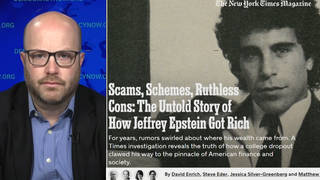
Guests
- Matt Taibbipolitical reporter for Rolling Stone magazine. His latest article is called “Ripping Off Young America: The College-Loan Scandal.”
On the heels of President Obama’s signing of a measure keeping federally subsidized student loans at a relatively low rate through 2015, Rolling Stone political reporter Matt Taibbi joins us to discuss how the high price of U.S. college tuition and the federal expansion of student debt to pay for it pose a major threat to the economy. In his new article, “Ripping Off Young America: The College-Loan Scandal,” Taibbi writes: “The dirty secret of American higher education is that student-loan interest rates are almost irrelevant. It’s not the cost of the loan that’s the problem, it’s the principal — the appallingly high tuition costs that have been soaring at two to three times the rate of inflation, an irrational upward trajectory eerily reminiscent of skyrocketing housing prices in the years before 2008. … Throw off the mystery and what you’ll uncover is a shameful and oppressive outrage that for years now has been systematically perpetrated against a generation of young adults.” Taibbi says the federal government is poised to make $185 billion over the next 10 years on student loans, with no way out for the young borrowers: “Even gamblers can declare bankruptcy, but kids who enter into student loans will never, ever be able to get out of this debt.”
Transcript
AARON MATÉ: We begin today with student loans. When President Obama signed it into law this month, the Bipartisan Student Loan Certainty Act was hailed as a major victory for students. The bill reversed a temporary doubling of the interest rate on federally subsidized Stafford student loans that took effect in July. Most students will pay a low rate of around 3.8 percent through 2015 but then see that rate jump as it becomes attached to financial markets. At the signing ceremony, President Obama praised Congress for reaching an agreement, but he warned the temporary fix in rates doesn’t address the underlying problem: the massive cost of college tuition and the debt burden imposed on students and their families.
PRESIDENT BARACK OBAMA: Even though we’ve been able to stabilize the interest rates on student loans, our job is not done, because the cost of college remains extraordinarily high. It’s out of reach for a lot of folks. And for those who do end up attending college, the amount of debt that young people are coming out of school with is a huge burden on them. It’s a burden on their families. It makes it more difficult for them to buy a home. It makes them more difficult—more difficult for them if they want to start a business. It has a depressive effect on our economy overall, and we’ve got to do something about it.
AMY GOODMAN: President Obama speaking in the Oval Office earlier this month.
Well, our next guest has just written an in-depth piece exploring the nation’s soaring education costs and their dangers. In the latest edition of Rolling Stone, Matt Taibbi argues that the high price of college tuition and the federal expansion of student debt to pay for it pose a major threat to the economy, as Taibbi writes, quote, “The dirty secret of American higher education is that student-loan interest rates are almost irrelevant. It’s not the cost of the loan that’s the problem, it’s the principal—the appallingly high tuition costs that have been soaring at two to three times the rate of inflation, an irrational upward trajectory eerily reminiscent of skyrocketing housing prices in the years before 2008. … Throw off the mystery and what you’ll uncover is a shameful and oppressive outrage that for years now has been systematically perpetrated against a generation of young adults.” Matt Taibbi’s article is called “Ripping Off Young America: The College-Loan Scandal.” He’s a political reporter for Rolling Stone.
Matt, welcome to Democracy Now!
MATT TAIBBI: Good morning.
AMY GOODMAN: So, lay it out for us. What is this scandal, as you describe it?
MATT TAIBBI: Well, there’s this overall connection between the sort of end—it’s very much like the housing crisis, where there was a limitless availability of credit that drove housing prices upward and upward until finally they collapsed. We have a similar dynamic going on here, where there’s sort of this bottomless well of government credit that keeps driving college costs up. And the difference here is not that it’s a market-based problem; it’s more that the government has limitless collection powers, so it has no fear of lending, and it continues to lend and lend and lend. And no matter how many defaults they get, they actually—some have argued that they actually make money on defaults, and they’re projecting a profit of $185 billion over the next 10 years.
AMY GOODMAN: How do they make money on the defaults?
MATT TAIBBI: Through fees and penalties. So, even when people default, even—and it’s not clear exactly how high the number is of defaults, but they’re able to farm those accounts out to collection services and the—for instance, a couple of years ago the government projected a recovery rate of 122 percent for all forms of Stafford loans that were in default. Now this year it’s a little bit lower; it’s somewhere between 103 and 109 percent. But it’s still above 100 percent, which gives you an indication of how easily they’re able to collect from people in default.
AARON MATÉ: Matt, can you explain what measures the government can take to collect, as compared to other defaults on different forms of loans?
MATT TAIBBI: Sure. They have—they can attach basically anything. They can attach a salary. They can attach a disability check. They can attach a tax return. They can prevent people from serving in the military. In some cases, they can prevent people from obtaining professional licenses. Basically, they—and they have, obviously, all the government’s tools at their disposal to find people. So, the recovery rate is much, much higher than it would be, say, for private credit cards. It’s probably five or six times higher than it is for that form of consumer debt.
AMY GOODMAN: Your—part of the power of your story is the examples. Talk about the 38-year-old attorney who had a pulmonary embolism.
MATT TAIBBI: Right, yeah. This is a guy who, just a few years out of law school, had a pulmonary embolism. He became fully disabled. A few years after that, he became bedridden. He was unable to work. He started receiving disability checks. And the instant he started getting his disability checks, he noticed that the government was garnishing $170 a month from his disability checks to pay for his student loans that he obviously took out to go to law school.
And this is a story that I heard—I heard a couple of similar stories. I heard a number of stories from women who wrote in saying that they didn’t have children because of their student loans. I had more than one person contact me and say that they had turned to a life of crime to pay for their student loans, because that—interestingly, because that was one form of income that they could obtain that the government couldn’t attach. And so, it’s unbelievable the stories that I got from people about their student loans and the effect they had on people’s lives.
AARON MATÉ: And, Matt, many people thought that this problem was at least partially solved in 2010 when Obama won that bill that basically revamped the student loan industry. Can you talk about what that was and why that did not go far enough?
MATT TAIBBI: Sure. Obviously, it was a good idea, I think. They essentially took out the middleman in the administration of federal—federally backed student loans. Now the government lends directly to students, which theoretically is a good idea. There’s no middlemen out there making extra profit, so that profit cost has been removed. But a few years ago, when they made that reform, the Congressional Budget Office projected that—essentially, that they were saving about $90 billion in profits that would have been collected by those private lenders as middlemen, but the projected profit now, over the same time period for the government, is twice as high. The government now projects that it’s going to make $185 billion over the next 10 years in student loans. And, of course, that’s just earning on interest and fees and penalties over that time period.
AMY GOODMAN: We’re going to break. When we come back, we’re going to hear from Senator Elizabeth Warren and also ask you, Matt Taibbi, about the actual costs of the colleges that the government is subsidizing and then that students are paying for—for the rest of their lives, in some cases. We’re talking to Matt Taibbi of Rolling Stone. Stay with us.
[break]
AMY GOODMAN: In our next segment, we’re going to be talking with the computer security analyst Jacob Appelbaum, who, himself, has been stopped at airports and detained by U.S. authorities over and over again, to talk about the fact that The Guardian reporter Glenn Greenwald’s partner, David Miranda, was stopped by British security at Heathrow Airport, held for nine hours. They took all of his computer equipment. And we’ll talk about what this means. But now we’re staying on student debt. I want to turn to Democratic Senator Elizabeth Warren speaking in July.
SEN. ELIZABETH WARREN: Our college students already see that the system is rigged against them. They watched Wall Street bankers get bailed out while their parents lost jobs and struggled to hang on to their homes. They see special subsidies for companies that ship jobs overseas and exploit tax loopholes, while the investments in their future and jobs at home disappear. And now Senator Coburn plans to squeeze more profits out of our students. He is fine with the government handing out loans to big banks at incredibly low rates, but he wants our students to pay more. That’s not who we are. This does not reflect our values. We see students drowning in debt, and we should be there to help.
Senator Harkin and Senator Reed have shown great leadership on this issue. They offer a simple solution to prevent interest rates from doubling. Their plan would maintain the current 3.4 percent interest rate for two more years. I’ve also introduced a short-term plan that would cut interest rates even more by offering the exact same rate that the big banks get through the Federal Reserve discount window. I introduced this one-year deal because we need immediate relief while we develop a long-term plan.
AMY GOODMAN: That was Senator Elizabeth Warren of Massachusetts. She voted against the student loan bill that was passed and President Obama signed. Our guest is Matt Taibbi, the political reporter for Rolling Stone. His piece is called “Ripping Off Young America: The College-Loan Scandal.” What about what Elizabeth Warren said?
MATT TAIBBI: Oh, I mean, I think she’s absolutely right. You know, interestingly, the compromise that they came to, that she was criticizing, while it does alleviate the cost of interest rates for students heading into this current school year, the CBO actually projects it to earn 715 more million dollars over the life of the program than the previous plan, which would have—
AMY GOODMAN: Because?
MATT TAIBBI: Because rates are expected to rise with the market over the next five to 10 years. So, while the previous plan would have earned $184 million and change—or $184 billion and change, this is $184,715,000,000. So it’s actually more expensive than the previous plan. And so, it’s a short-term fix, and I sympathize with those members in Congress and in the Senate who were critical of it.
AMY GOODMAN: Do kids understand this? I mean, talk about who this is all being marketed to.
MATT TAIBBI: Right, and this is the huge problem that you come up against over and over again with people who have student debt, is that they’re—most of them made this decision when they were 18 or 19 years old. They go into a financial aid office. Lenders are exempt from all sorts of requirements that other kinds of lenders are legally bound to have, though. You know, there’s no requirement to disclose all the different consequences. You don’t have to emphasize things like APR, annual percentage rate. And so, kids go in there. They know nothing. They can barely do a load of laundry at that age, much less handle a complicated financial transaction. And they essentially are signing up for the equivalent of a first mortgage, and they’re going to be stuck with it for their entire lives. There’s no bankruptcy protection for these kids, and they don’t understand that. There is no way out of these loans. Even gamblers can declare bankruptcy, but kids who enter into student loans will never, ever be able to get out of this debt. And so, if they don’t get the high-paying job that they expect, and they go into a program for nautical archaeology or orchestra conducting and they don’t get that job, they’re going to be stuck with this forever. And the forbearances end very, very quickly after graduation, so if you can’t make that money, you’re going to be in trouble really, really fast.
AARON MATÉ: Matt, the figures are staggering: $1 trillion overall in student debt, the average student leaves college owing $27,000. Can you talk about why, in your piece, you compare this to the housing bubble?
MATT TAIBBI: Well, right. Again, it’s—first of all, apparently, The Wall Street Journal, after I wrote this piece, they released a study saying the average debt is now $40,000, so it’s growing at an exponential rate.
But even though the Federal Reserve last year—they compared this to the housing bubble, because, again, it’s the same thing. It’s irrationally rising prices. What happened in the housing bubble? You had a market where banks were disguising the underperforming loans of subprime borrowers as AAA-rated securities, and they were able to market those loans all over the world, to pension funds and unions, and thus they had this never-ending market for what were essentially worthless, toxic loans.
Here we have a similar situation where there’s just an endless amount of credit that the government is putting into the market to prop up college tuition prices, which keep going up and up and up the more aid we make available. So there’s no natural check on the price of college. And colleges know this, and they keep going back and asking the government to raise lending limits. And every time they do it, they raise the price of college. And, of course, this is happening at the same time that states are going bankrupt, so they’re subsidizing this less and less and less. And it more and more becomes on the backs of young kids who take out student—federally backed student loans and do not know what they’re getting into. It’s essentially a hidden tax on kids who don’t know what they’re doing.
AMY GOODMAN: Matt Taibbi, talk about the university costs, what these soaring tuition fees are.
MATT TAIBBI: Sure. University costs have been rising at roughly three times the rate of inflation over the last couple of decades, three times the rate of the consumer price index. They’re just going up at an exponential rate. And again, this is tied almost entirely to the availability of credit. A lot of the people that I talked to—essentially, the availability of government credit benefits two actors. There’s the government, which makes an enormous profit on it, that $185 billion. And then you have these universities, their contractors, who are building all those swimming pools and hanging gardens and hotel-like dormitories on their campuses, what one administrator called “gilding” to me, this sort of prettying up of campuses. But there’s also this sort of endless hiring of administrators and sub-provosts and provosts who make six-figure incomes. And they’re fattening up these colleges with this gilding, and it’s all government contracting money. It’s the same kind of thing that goes on in the military, where you build, you know, a $75 million prison, when it could have been a $1 million prison.
AMY GOODMAN: You say that this should be a problem for conservatives, and it should be a problem for progressives, you know, following their philosophies. Explain.
MATT TAIBBI: Well, the conservatives should be upset because this is the government interfering in a market process. Prices for college—there would naturally be a check on prices if they had to compete with each other more. Instead, because of this endless availability of credit, they can continually raise prices. And because of the government’s ability to collect on defaulted loans—this unbelievable ability that surpasses anything that happens in private industry—they’re able to keep cranking out this credit, and it’s propping up otherwise underperforming colleges that are not providing the degrees that are leading to good jobs. So it’s a market-altering situation that they should be very much opposed to.
And progressives, on the other hand, should be upset that you have this industry that, A, is engaged in systematic predatory lending—that’s what colleges are essentially doing, they’re living off predatory lending—and it’s a massive subsidy, a state subsidy, for an underperforming industry that is essentially robbing taxpayers. They should be upset about—everybody should be upset about that.
AMY GOODMAN: So what has to be done, very quickly, and who—who is profiting from the current system?
MATT TAIBBI: Well, the people who are profiting are the contractors who are building up these universities, the university administrators who are making these enormous salaries. In some cases, it’s professors, although, of course, there are fewer tenure-track jobs than there ever were now, but it’s mostly administration, contracting. And then, of course, it’s the government that’s making an enormous profit on these loans. But something has to be done to sort of check this availability of credit and force colleges to make more rational decisions about pricing and about—and force kids to understand better the consequences of what they’re getting into when they sign up for these loans.
AMY GOODMAN: Matt Taibbi, we want to thank you very much for being with us, political reporter for Rolling Stone. His latest piece is called “Ripping Off Young America: The College-Loan Scandal.” We’ll link to it at democracynow.org.












Media Options